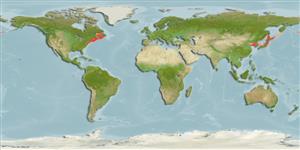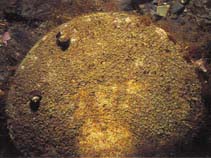Placopecten magellanicus (Gmelin, 1791)
Deep sea scallop| Native range | All suitable habitat | Point map | Year 2050 |

|
| This map was computer-generated and has not yet been reviewed. |
| Placopecten magellanicus AquaMaps Data sources: GBIF OBIS |
Classification / Names Κοινά ονόματα | Συνώνυμα | CoL | ITIS | WoRMS
Bivalvia | Pectinida | Pectinidae
Environment: milieu / climate zone / εύρος βάθους / distribution range Οικολογία
; εύρος βάθους 0 - 300 m (Αναφ. 83435), usually 30 - 91 m (Αναφ. 83435). Temperate, preferred 9°C (Αναφ. 107945); 52°N - 35°N, 75°E - 56°W (Αναφ. 83435)
Distribution Χώρες | Περιοχές FAO | Οικοσυστήματα | Παρουσίες | Εισαγωγές
Western Central Pacific and Northwest Atlantic: Palau, Canada to USA.
Length at first maturity / Μέγεθος / Weight / Age
Γεννητική Ωρίμανση: Lm ? range ? - ? cm Max length : 20.0 cm TL αρσενικό/απροσδιόριστο; (Αναφ. 7726); μεγ. αναφερόμενη ηλικία: 12 έτη (Αναφ. 8702)
Life cycle and mating behavior Γεννητική Ωρίμανση | Αναπαραγωγή | Γεννοβολία | Eggs | Γονιμότητα | Larvae
Main reference
Αναφορές | Συντονιστής | Συνεργάτες
Harvey-Clark, C. 1997. (Αναφ. 7726)
IUCN Red List Status
(Αναφ. 130435: Version 2024-2)
CITES status (Αναφ. 108899)
CMS (Αναφ. 116361)
Threat to humans
Human uses
αλιεία: Εμπορικό(ά)
FAO - αλιεία: landings, species profile | FishSource | Η θάλασσα γύρω μας
Εργαλεία
Περισσότερες πληροφορίες
Διαδικτυακές πηγές
BHL | BOLD Systems | CISTI | DiscoverLife | FAO(αλιεία: species profile; publication : search) | Fishipedia | GenBank (genome, nucleotide) | GloBI | Gomexsi | Google Books | Google Scholar | Google | PubMed | Δέντρο Ζωής | Wikipedia (Go, αναζήτηση) | Zoological Record



